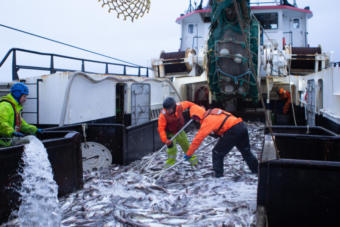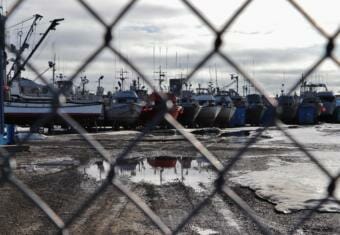
In a normal fishing season, Dan Martin would fly straight from the Pacific Northwest to the Aleutian Islands, where his pollock trawler, the Commodore, would be waiting for him to take the wheel.
But this year, the veteran skipper is stepping onboard in Seattle, where he, four crew and two federal fisheries observers are taking COVID-19 tests and hoisting a quarantine flag. Then they’ll squeeze onto the vessel for a week-long voyage to Alaska’s biggest fishing port, Dutch Harbor in the Aleutian Islands.
“We might have to eat in shifts,” Martin quipped. “Because I don’t know that we can fit that many people at our galley table.”
There’s no hospital anywhere in the Aleutians, and Dutch Harbor has not yet seen a single confirmed case of COVID-19. Martin says the industry’s biggest fear is bringing the virus in with them.
That fear is not theoretical: A different vessel that fishes for Bering Sea pollock, with an onboard processing plant, returned to a Washington port last week with at least 86 people infected with the disease. And in Alaska, 14 nonresident seafood industry workers have already tested positive for COVID-19.
In Dutch Harbor, Martin and his crew will sit on the boat for another week to finish out their 14-day quarantine. Then, during their months-long season, the only time they’ll get off the boat is for outdoor recreation with each other — no trips to the town swimming pool or dinners at the Norwegian Rat Saloon. Martin said he’s girding himself for a long summer on the boat’s tight quarters.
“If you have the guy who squeezes the toothpaste in the middle, versus somebody who rolls it up from the bottom — that might be something that tips somebody over come the end of the August, and you’ve just been shut in with these people for three months,” he said.
Alaska’s seafood industry sprawls across dozens of communities and thousands of miles of coastline. But one common theme is that this summer’s fishing season represents uncharted waters.

With hundreds of millions of dollars worth of fish still available for harvest, thousands of fishermen and processing plant workers are set to arrive in coastal Alaska communities from Outside, where COVID-19 infection rates are much higher. But seafood companies, fishermen and local leaders say they’ve set up systems to limit the risk that the visitors could spread infection and overwhelm rural Alaska’s limited health-care infrastructure.
“I feel calm. I feel prepared. We have put a lot of work into this plan,” said Melanee Tiura, chief executive of the nonprofit that runs the sole clinic in Unalaska, the island community that includes Dutch Harbor. “Our solid processes and our good relationships between industry, with the Coast Guard, with our medevac planes, with the city — I think that we’re going to do very well.”
Tiura said her organization expects to see cases over the course of the summer, but is far better prepared to handle them than at the start of the pandemic. It’s secured multiple testing units and helped set up a quarantine site, where people with COVID-19 can recover without the risk of infecting their colleagues or co-workers, she said.
But a major local outbreak would still present serious challenges: Unalaska’s clinic has just three ventilators for the community’s 4,500 people.
For state officials, the goal this summer is to keep COVID-19 from spreading from industrial settings into surrounding communities, said Bryan Fisher, incident commander for Alaska’s response to the pandemic.
The state has mandated quarantines and other precautions for independent fishermen, and required fishing and processing businesses to draft protective plans that, in many cases, include requirements for testing and strict lockdowns at plants. There are also new recommendations aimed at keeping the disease from spreading on processing plant floors, given problems in Outside meat plants, Fisher added.
So far, the state’s efforts appear to be succeeding, even as workers have tested positive for the disease in some isolated coastal towns, Fisher said.
“We haven’t seen, to date, any community transmission spread with those cases associated with the fishing industry,” he said.
Tests inside and outside Alaska
In most coastal towns, the salmon season is still weeks away. But after two months of negotiation between seafood companies, fishermen, local governments and state officials, plans for the movement of thousands of seasonal workers are finally coming to fruition.
Those plans vary between different areas of the fishing industry, and independent fishermen who own their own boats have to follow a special mandate imposed by Gov. Mike Dunleavy.
But there are similar themes involving widespread testing and quarantining. Take the plan adopted by Silver Bay Seafoods, which operates processing plants in Sitka, Prince William Sound, Bristol Bay, Kodiak and the Aleutians.
Before flying to Alaska, seasonal workers must quarantine themselves for two weeks, with twice-daily checks for symptoms, then test negative for COVID-19, Abby Fredrick, a Silver Bay spokeswoman, wrote in an email.
After flying to plants in Alaska, workers will go through another, monitored two-week quarantine, with a final test at the end.
So far, the company has tested nearly 200 people outside Alaska, with one positive result, Fredrick said. More than 200 employees have been tested inside the state without any positives.

Other companies have slightly different protocols: Trident Seafoods, one of the country’s largest, is flying workers to Anchorage, quarantining them in hotel rooms under the watch of security guards for two weeks, then testing them at the end of that period. Once they’re cleared, they’re flown to remote processing plants on chartered planes to minimize exposure.
Trident wouldn’t say exactly how many of its workers have tested positive. But it’s finding cases in less than 2% of employees at the end of the quarantine period, said spokesman Shannon Carroll.
Positive tests prove the system “is working”
In addition to the 14 nonresident seafood industry workers who have tested positive for COVID-19 inside Alaska, one particular company has caught more 10 infected workers before they’ve even flown to the state, said Fisher, the incident commander.
“Each of those cases that were discovered, whether it was out of state or in state, is proof that the system we put in place is working — to make sure that we’re not spreading the virus in a processing plant, or on a fishing boat, or more particularly in communities where the fisheries are happening,” Fisher said in a phone interview.
The state has also made strong recommendations about how seafood companies will manage the floors of their processing plants, to keep COVID-19 from spreading there, Fisher said. The disease has infected thousands of workers in meat processing plants outside Alaska.
The state’s recommended precautions include segregating employees into self-contained working groups, which would make it easier to track and isolate them in the event that someone tests positive. Other recommendations include avoiding close contact, using personal protective equipment and installing physical barriers between workers, Fisher said.
Those measures are not required, he said. But companies have gone “above and beyond,” he added.
“What industry has told us is they understand the need to keep the communities safe that they’re working in,” Fisher said. “They understand the implications of what it would mean to have a widespread community outbreak coming from one of their plants.”
Once processing workers arrive at their plants for the summer, many won’t be allowed to leave for the duration of the season, as a number of companies are putting their properties on lockdown.
To keep workers from going stir-crazy, Trident has invested in ping-pong and karaoke at one of its plants, and it’s offering streaming yoga and other workout classes, and video games, during quarantines.
Silver Bay bought extra gym equipment, movie and gaming centers, books and billiards, Frederick said. It’s also helped arrange English classes for employees who were stuck between seasons at an isolated plant in the Aleutians, and in Sitka, residents donated an array of games “to show their support for Silver Bay’s commitment to isolate from the community,” she added.
In Valdez, the local government is paying for a security checkpoint on the road that connects processing plants with the rest of town. Designated “runners” from the plants can pick up mail and supplies in town, but they must be segregated from other workers, with private living spaces and non-communal meals, according to agreements that Valdez’s two major seafood companies have signed with the city.
“Everybody wants this to succeed,” said Mayor Jeremy O’Neil, who’s also the administrator of Valdez’s hospital. “From the get-go, the work with the fish processors, the fishing fleet, has been very collaborative.”
O’Neil acknowledged the power of COVID-19 to throw “wrenches” and “curveballs” at the city’s plans, adding: “The jury’s still out on what lies ahead over the next couple of months.”
“It’s going to be a long summer,” he said.
Waiting for the fishermen to go home
Uncertainty also persists in Bristol Bay, which has seen some of the loudest outcry over the Dunleavy administration’s plans to proceed with the sockeye fishery.
On the east side of the bay, which is home to most of the region’s major processing plants, Samaritan’s Purse, the evangelical Christian relief organization, flew in equipment Monday for a 30-bed field hospital that can be used if an outbreak develops.
Dan O’Hara, mayor of the surrounding Bristol Bay Borough, praised seafood companies for drafting and executing plans to keep their summer workforce isolated from local residents.

“They’ve done an excellent job of taking care of what they said they were going to do,” he said.
O’Hara said the borough is taking its own precautions, including hiring “safety monitors” to make sure fishermen and processing workers are abiding by state and company health mandates. But if cases of COVID-19 become unmanageable, the borough Assembly can also shut down fishing by cutting off access to its dock.
That could cost the borough millions of dollars in revenue, but it has enough set aside in savings to survive for a year or two, O’Hara said.
“We’re not beholden to anybody,” he said. “I don’t care what the governor says: If this comes to a place where we feel that this is a threat to our elderly people and our citizens, that dock will be shut down in a heartbeat, I guarantee you.”
On the west side of the bay, anxiety has been more acute in the hub town of Dillingham. With fishermen starting to arrive, Jamie O’Connor, a spokeswoman for the local government, said the city is still waiting for Dunleavy’s administration to send security contractors to help enforce state health mandates.
Health Commissioner Adam Crum, in an email Monday, said the contract was being finalized, though he would not provide details.
Robin Samuelsen, a Dillingham Native leader, said he’s pleased that seafood companies have been testing plant workers and catching cases that way. He was also happy to see three city policy officers greeting new arrivals at the airport Monday, he said.
But the impending arrival to Bristol Bay of thousands of independent fishermen, who aren’t subject to seafood company policies, is still making him nervous, Samuelsen said.
“A lot of these fishermen think it’s the Wild West out here,” he said. “We can’t wait until we see them leaving.”
